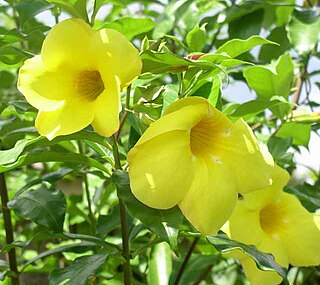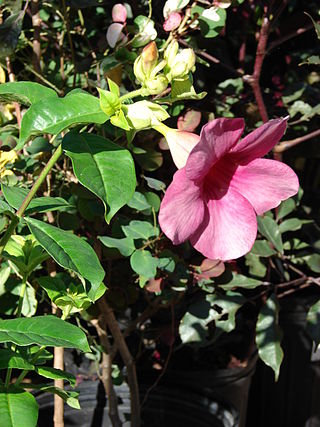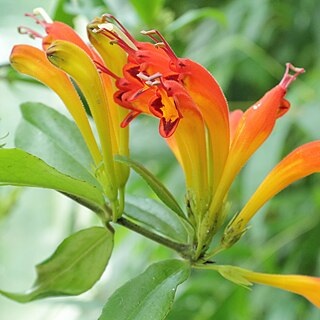
Salvia rosmarinus, commonly known as rosemary, is a shrub with fragrant, evergreen, needle-like leaves and white, pink, purple, or blue flowers, native to the Mediterranean region. Until 2017, it was known by the scientific name Rosmarinus officinalis, now a synonym.

Prunus cerasus is a species of Prunus in the subgenus Cerasus (cherries), native to much of Europe, North Africa and West Asia. It is closely related to the sweet cherry, but has a fruit that is more acidic. Its sour pulp is edible.

Morus, a genus of flowering plants in the family Moraceae, consists of diverse species of deciduous trees commonly known as mulberries, growing wild and under cultivation in many temperate world regions. Generally, the genus has 64 subordinate taxa, three of which are well-known and are ostensibly named for the fruit color of the best-known cultivar: white, red, and black mulberry, with numerous cultivars and some taxa currently unchecked and awaiting taxonomic scrutiny. M. alba is native to South Asia, but is widely distributed across Europe, Southern Africa, South America, and North America. M. alba is also the species most preferred by the silkworm, and is regarded as an invasive species in Brazil and the United States.

Cornus florida, the flowering dogwood, is a species of flowering tree in the family Cornaceae native to eastern North America and northern Mexico. An endemic population once spanned from southernmost coastal Maine south to northern Florida and west to the Mississippi River. The tree is commonly planted as an ornamental in residential and public areas because of its showy bracts and interesting bark structure.

Apocynaceae is a family of flowering plants that includes trees, shrubs, herbs, stem succulents, and vines, commonly known as the dogbane family, because some taxa were used as dog poison. Members of the family are native to the European, Asian, African, Australian, and American tropics or subtropics, with some temperate members. The former family Asclepiadaceae is considered a subfamily of Apocynaceae and contains 348 genera. A list of Apocynaceae genera may be found here.

Abutilon is a large genus of flowering plants in the mallow family, Malvaceae. It is distributed throughout the tropics and subtropics of the Americas, Africa, Asia, and Australia. General common names include Indian mallow and velvetleaf; ornamental varieties may be known as room maple, parlor maple, or flowering maple. The genus name is an 18th-century Neo-Latin word that came from the Arabic ’abū-ṭīlūn, the name given by Avicenna to this or a similar genus.

Allamanda is a genus of flowering plants in the family Apocynaceae. They are native to the Americas, where they are distributed from Mexico to Argentina. Some species are familiar as ornamental plants cultivated for their large, colorful flowers. Most species produce yellow flowers; A. blanchetii bears pink flowers. The genus name Allamanda honors the Swiss botanist and physician Frédéric-Louis Allamand (1736–1809). It is the official flower of Kuching North City Hall.

Hibiscus syriacus is a species of flowering plant in the mallow family, Malvaceae. It is native to south-central and southeast China, but widely introduced elsewhere, including much of Asia, both in the east and the west. It was given the epithet syriacus because it had been collected from gardens in Syria. Common names include the rose of Sharon,, Syrian ketmia, shrub althea, and rose mallow. It is the national flower of South Korea and is mentioned in the South Korean national anthem.

Dasiphora fruticosa is a species of hardy deciduous flowering shrub in the family Rosaceae, native to the cool temperate and subarctic regions of the northern hemisphere, often growing at high altitudes in mountains. Dasiphora fruticosa is still widely referenced in the horticultural literature under its synonym Potentilla fruticosa. Common names include shrubby cinquefoil, golden hardhack, bush cinquefoil, shrubby five-finger, widdy, and kuril tea.

Ficus elastica, the rubber fig, rubber bush, rubber tree, rubber plant, or Indian rubber bush, Indian rubber tree, is a species of flowering plant in the family Moraceae, native to eastern parts of South and Southeast Asia. It has become naturalized in Sri Lanka, the West Indies, and the US state of Florida. Despite its common names, it is not used in the commercial production of natural rubber.

Chilopsis is a monotypic genus of flowering plants containing the single species Chilopsis linearis. It is known commonly as desert willow or desert-willow because of its willow-like leaves, but it is not a true willow – being instead a member of the catalpa family.

Cordia sebestena is a shrubby tree in the borage family, Boraginaceae, native to the American tropics. It ranges from southern Florida in the United States and the Bahamas, southwards throughout Central America and the Greater Antilles. Common names have included siricote or kopté (Mayan) in 19th Century northern Yucatán, scarlet cordia in Jamaica, and Geiger tree in Florida.
Trumpetflower or trumpet flower may refer to several plants:

Allamanda blanchetii is a species of perennial flowering plant in the family Apocynaceae native to Brazil. Cultivated as an ornamental plant, it grows in full sun in USDA Zones 9b through 11 including central and south Florida, southernmost Texas, and coastal California. This plant's purple, bell-shaped blooms are about 3" across. It is also called red bell. From the stem fiber can be extracted which is very strong and silky white after chemical treatment.

Allamanda schottii, commonly known as bush allamanda, is a shrub of genus Allamanda in the family Apocynaceae, which is native to Brazil. Reaching 2.5 metres (8.2 ft) in height, it bears large yellow flowers for much of the year. Grown as an ornamental plant, it has become a weed in several countries.

Acalypha hispida, the chenille plant, is a flowering shrub which belongs to the family Euphorbiaceae, the subfamily Acalyphinae, and the genus Acalypha. Acalypha is the fourth largest genus of the family Euphorbiaceae, and contains many plants native to Hawaii and Oceania.

Tecomaria capensis, the Cape honeysuckle, is a species of flowering plant in the family Bignoniaceae, native to southern Africa. Despite its common name, it is not closely related to the true honeysuckle.

Rhamnus cathartica, the European buckthorn, common buckthorn, purging buckthorn, or just buckthorn, is a species of small tree in the flowering plant family Rhamnaceae. It is native to Europe, northwest Africa and western Asia, from the central British Isles south to Morocco, and east to Kyrgyzstan. It was introduced to North America as an ornamental shrub in the early 19th century or perhaps before, and is now naturalized in the northern half of the continent, and is classified as an invasive plant in several US states and in Ontario, Canada.

Veronica odora, known as the boxwood hebe, mountain-box, Hebe odora or Hebe buxifolia, is a plant in the family Plantaginaceae, and it is native to New Zealand. Veronica odora was discovered on the Auckland Islands by J.D Hooker in 1840. A certain amount of confusion later arose following its collection on mainland New Zealand by Ernst Dieffenbach and its naming as Veronica buxifolia by George Bentham. Even overseas, Veronica odora is still not infrequently known as Veronica buxifolia.

Aeschynanthus speciosus, also known as the basket plant, is a species of flowering plant in the family Gesneriaceae. There are many species of Aeschynanthus, all of which have long, trailing stems and bright flowers. The large, fleshy, dark green leaves are up to 10 cm (4 in) long and 4 cm wide and are arranged in groups along the stems. The flowers can be as long as 10 cm (4 in) and grow in clusters that usually consist of 6–20 flowers. Most of the time they are shaded in different colors, from orange–yellow in the lower area to orange–red at the tip with a blotched red inside and a yellow streaked throat.
























